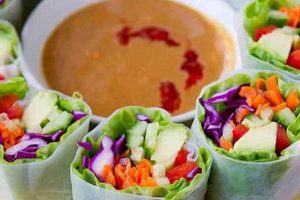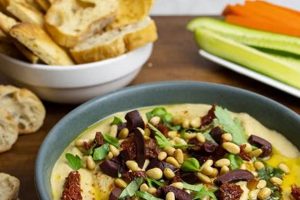Plant-based seafood alternatives designed to mimic the flavor and texture of crab have emerged as a significant food innovation. These products typically utilize ingredients like hearts of palm, jackfruit, or konjac root, processed and seasoned to replicate the distinctive taste of crustacean-derived meat. For example, seasoned hearts of palm can be shredded and combined with seaweed extracts to simulate the appearance and saline flavor profile found in traditional seafood dishes.
The development of such alternatives addresses growing concerns regarding overfishing, environmental sustainability, and animal welfare. The increasing demand for seafood places immense pressure on marine ecosystems, leading to population depletion and habitat destruction. Plant-based alternatives offer a potentially more sustainable and ethical option, reducing reliance on vulnerable marine resources. Furthermore, these options can cater to individuals with dietary restrictions, allergies, or ethical considerations preventing the consumption of animal products.
This article will delve into the specific ingredients, manufacturing processes, nutritional profiles, and culinary applications of these innovative seafood replacements. A thorough examination of their environmental impact and consumer acceptance will also be presented, providing a comprehensive overview of this developing food sector.
Preparation and Usage Guidelines
Optimizing the culinary experience requires thoughtful consideration when preparing and utilizing plant-based crab alternatives. These guidelines aim to enhance flavor and texture while ensuring proper food safety protocols are followed.
Tip 1: Proper Thawing: If the product is frozen, ensure complete thawing in the refrigerator prior to use. Avoid thawing at room temperature to minimize the risk of bacterial growth.
Tip 2: Gentle Handling: Due to the delicate nature of some plant-based formulations, handle with care to prevent crumbling or disintegration during preparation.
Tip 3: Seasoning Enhancement: While pre-seasoned options are available, consider adding complementary flavors such as Old Bay seasoning, lemon juice, or fresh herbs to amplify the taste profile.
Tip 4: Cooking Time Adjustment: Plant-based alternatives generally require shorter cooking times than traditional crab meat. Overcooking can result in a rubbery or undesirable texture.
Tip 5: Culinary Versatility: Explore a wide range of applications, from crab cakes and salads to dips and fillings. Experiment with different recipes to discover optimal usage techniques.
Tip 6: Complementary Ingredients: Enhance the overall dish by pairing it with complementary ingredients such as avocado, mango, or citrus-based sauces.
Tip 7: Food Safety Practices: Adhere to standard food safety practices, including thorough handwashing and clean preparation surfaces, to prevent cross-contamination.
By implementing these preparation and usage guidelines, consumers can maximize the flavor and enjoyment of plant-based crab alternatives, contributing to both culinary satisfaction and responsible dietary choices.
The following sections will address common misconceptions and further expand on the environmental impact of these innovative food products.
1. Ingredients
The selection of ingredients is paramount to the success of any plant-based crab alternative. These components dictate not only the final product’s flavor and texture but also its nutritional profile and overall sustainability. Careful consideration of ingredient sources and processing methods is therefore crucial.
- Base Material
The base material forms the structural foundation of the product, providing the bulk and texture. Common options include hearts of palm, jackfruit, konjac root (glucomannan), and soy protein. Each material contributes unique characteristics. Hearts of palm, for instance, offer a naturally flaky texture, while konjac root contributes a gelatinous mouthfeel. The selection of the base material significantly impacts the final product’s resemblance to traditional crab meat.
- Flavoring Agents
Achieving an authentic crab flavor requires the strategic use of flavoring agents. These typically include seaweed extracts, such as kelp or nori, to impart a marine-like salinity. Other common additions include paprika, celery seed, onion powder, and garlic powder to mimic the complex flavor profile of crab. Careful balancing of these elements is essential to avoid an artificial or overpowering taste.
- Binding Agents
Binding agents are necessary to hold the ingredients together, particularly after cooking. Methylcellulose, a plant-derived cellulose derivative, is frequently used for its heat-gelling properties. Other options include tapioca starch and potato starch, although these may impact the overall texture. The choice of binding agent directly affects the product’s structural integrity and cooking performance.
- Coloring Agents
Replicating the visual appearance of crab meat often involves the use of coloring agents. Natural options include beet juice for a pinkish hue and paprika extract for a reddish-orange tint. Synthetic food colorings are also sometimes employed, though increasingly less common due to consumer preferences for natural ingredients. The use of coloring agents contributes to the overall sensory appeal of the product.
The interplay of these ingredients is critical in creating a convincing plant-based crab alternative. A product might, for instance, combine hearts of palm for texture, seaweed extract and Old Bay seasoning for flavor, methylcellulose for binding, and beet juice for color. The specific combination and proportion of these ingredients determine the product’s ultimate success in replicating the taste, texture, and appearance of real crab meat, while also influencing its nutritional value and environmental impact.
2. Texture
The textural component of plant-based crab alternatives is a critical determinant of consumer acceptance and overall product success. The desired outcome is to emulate the fibrous, flaky, and slightly yielding consistency of genuine crab meat. Failure to achieve a convincing texture can result in negative perceptions, regardless of flavor accuracy. The appropriate texture directly influences the perceived authenticity and palatability of the product.
Ingredients and processing methods play a pivotal role in creating the desired textural attributes. Hearts of palm, for example, inherently possess a layered structure that can be manipulated to mimic flakiness. Jackfruit, when properly prepared, offers a stringy quality that approximates the muscle fibers found in crab. Furthermore, techniques such as shredding, layering, and the addition of texturizing agents like konjac flour or methylcellulose contribute to achieving the targeted consistency. The interplay between ingredient selection and manufacturing techniques is essential. An example is using jackfruit seasoned to replicate crab flavor and then steamed to retain its structural integrity to simulate crab meat.
Ultimately, the successful replication of crab’s texture in plant-based alternatives is not merely an aesthetic concern but a functional one. It directly impacts the overall sensory experience and influences consumers’ willingness to adopt these products as viable substitutes for traditional seafood. Ongoing research and development efforts continue to refine ingredient combinations and processing methods, aiming to achieve increasingly realistic and satisfying textural outcomes. This pursuit addresses the challenge of consumer expectations and links directly to the broader theme of sustainable and ethical food production.
3. Sustainability
The advent of plant-based crab alternatives directly addresses environmental concerns associated with traditional crab harvesting. Overfishing, habitat destruction, and bycatchthe unintentional capture of non-target speciesare significant problems within the crab fishing industry. These issues contribute to biodiversity loss and disrupt delicate marine ecosystems. Opting for plant-based substitutes mitigates the demand for wild-caught crab, reducing pressure on vulnerable populations and lessening the ecological footprint. For example, the Chesapeake Bay blue crab population, a historically abundant species, has faced significant challenges due to overfishing and habitat degradation. Plant-based options offer a pathway to reduce reliance on this struggling ecosystem.
The sustainability of plant-based options, however, is not absolute and requires careful consideration of the sourcing and production methods involved. The environmental impact of ingredients like hearts of palm or jackfruit depends heavily on farming practices, transportation logistics, and land use considerations. Sustainable sourcing certifications, such as those ensuring responsible forestry practices or fair labor standards, can help guarantee that the production of these ingredients aligns with environmentally sound principles. Furthermore, the energy consumption and waste generation associated with manufacturing plant-based crab alternatives must be minimized to ensure genuine sustainability gains. Life cycle assessments can provide a comprehensive analysis of the environmental impacts across the entire supply chain, from ingredient cultivation to product disposal.
In conclusion, the adoption of plant-based crab alternatives presents a tangible opportunity to promote sustainability within the seafood sector. While challenges remain in ensuring responsible sourcing and production practices, these innovations offer a pathway to reduce reliance on ecologically damaging fishing methods. The long-term success of plant-based crab hinges on continuous improvement in sustainability metrics and transparency throughout the supply chain, thereby fostering a more resilient and environmentally conscious food system. The potential benefits of these alternatives significantly outweigh the environmental burden posed by traditional methods of crab acquisition.
4. Nutrition
The nutritional composition of plant-based crab alternatives is a significant factor in their appeal and viability as substitutes for traditional crab meat. While these alternatives aim to replicate the flavor and texture of crab, their nutritional profiles often differ considerably. Understanding these differences is essential for informed dietary choices.
- Protein Content
Traditional crab meat is a rich source of high-quality protein, crucial for muscle building and overall bodily function. Plant-based alternatives vary widely in their protein content, depending on the primary ingredients used. Soy-based options generally offer a comparable protein level, while alternatives based on hearts of palm or jackfruit tend to be lower in protein. Consumers seeking a protein-rich substitute should carefully examine the nutritional information label. For example, a 100-gram serving of real crab may contain around 20 grams of protein, whereas a similar serving of a hearts-of-palm based product may only offer 2-3 grams.
- Sodium Levels
Sodium content is an important consideration, as both traditional crab meat and its plant-based counterparts can be high in sodium, particularly if heavily seasoned. Excessive sodium intake is linked to elevated blood pressure and other health concerns. Examining the sodium content per serving is crucial, and choosing lower-sodium options, if available, is advisable. For example, some imitation crab products have high sodium content due to their manufacturing process.
- Omega-3 Fatty Acids
Crab meat is a source of omega-3 fatty acids, which are beneficial for heart health and brain function. Plant-based alternatives generally do not naturally contain significant amounts of omega-3s. However, some manufacturers fortify their products with algal oil or other plant-based sources of omega-3 fatty acids to enhance their nutritional value. Checking the ingredient list and nutritional information is vital to determine if a product is fortified with omega-3s.
- Fiber Content
Plant-based crab alternatives often provide a higher fiber content compared to traditional crab meat, depending on the ingredients used. Fiber contributes to digestive health and can promote feelings of fullness. Ingredients like hearts of palm and konjac root are naturally good sources of fiber. This added fiber is a nutritional advantage not found in traditional crab meat.
In summary, while plant-based crab alternatives offer potential benefits in terms of sustainability and ethical considerations, their nutritional profiles differ significantly from traditional crab meat. Consumers should carefully evaluate the protein, sodium, omega-3 fatty acid, and fiber content of these products to make informed choices that align with their individual dietary needs and health goals. A balanced diet incorporating a variety of nutrient sources remains essential.
5. Applications
The range of culinary applications significantly influences the market viability and consumer adoption of plant-based crab alternatives. The successful integration of these products into diverse dishes, mirroring the versatility of traditional crab meat, determines their long-term relevance. If plant-based substitutes are limited in their use cases, their appeal diminishes despite potential advantages in sustainability or ethical sourcing. Therefore, demonstrating broad applicability is crucial for establishing these products as legitimate replacements for seafood.
Examples of successful applications showcase the potential of plant-based crab. These include the creation of vegan crab cakes, where the texture and flavor of the alternative bind effectively with other ingredients. Similarly, incorporation into salads, dips, and seafood pasta dishes demonstrates the product’s adaptability. The ability to withstand different cooking methods, such as baking, frying, and steaming, further expands its culinary potential. Restaurants and food manufacturers increasingly incorporate these alternatives into their menus and product lines, reflecting their growing acceptance and versatility. For instance, vegan sushi rolls containing plant-based crab filling are gaining popularity, as are plant-based crab Rangoon appetizers. The successful replication of popular crab-based dishes drives consumer interest and market expansion.
Ultimately, the practical significance of understanding the applications of plant-based crab lies in its ability to promote wider acceptance of sustainable and ethical food choices. By demonstrating versatility and ease of use, these alternatives can seamlessly integrate into existing culinary practices. This seamless integration reduces barriers to adoption, thereby contributing to a more sustainable and responsible food system. The development and refinement of diverse applications remain essential for the continued growth and acceptance of this product category, thereby mitigating environmental impacts associated with traditional crab harvesting.
Frequently Asked Questions Regarding Plant-Based Crab Alternatives
The following section addresses common inquiries and misconceptions surrounding plant-based crab substitutes, providing clear and concise information for consumers seeking a deeper understanding of this food category.
Question 1: What exactly is vegan crab meat made of?
Plant-based crab alternatives typically utilize ingredients such as hearts of palm, jackfruit, konjac flour, and/or soy protein as their base. These are processed and combined with flavoring agents, including seaweed extracts, and spices to mimic the taste and texture of real crab meat.
Question 2: Is plant-based imitation crab actually healthier than real crab?
The nutritional profile varies greatly depending on the specific product. While plant-based options may be lower in calories and fat, they might also contain less protein and omega-3 fatty acids. Sodium content should be carefully considered. Examining the nutritional label is crucial for making informed dietary choices.
Question 3: Are there any allergy concerns with plant-based crab substitutes?
Yes, potential allergens depend on the ingredients used. Soy-based alternatives pose a risk to individuals with soy allergies. Similarly, other ingredients, such as wheat or gluten-based binders, could trigger allergic reactions. Always review the ingredient list before consumption.
Question 4: How does the taste of plant-based alternatives compare to real crab meat?
The taste varies significantly depending on the specific product and the quality of the flavoring agents used. Some alternatives effectively mimic the sweet and savory flavor of crab, while others may have a noticeably different taste. Consumer reviews and experimentation can help in finding a product that meets individual preferences.
Question 5: Is vegan crab widely available for purchase?
Availability has increased substantially in recent years. Plant-based crab alternatives can now be found in many grocery stores, health food stores, and online retailers. The selection may vary depending on geographic location and retailer.
Question 6: What is the environmental impact of producing plant-based imitation crab?
While generally considered more sustainable than traditional crab fishing, the environmental impact depends on the sourcing and production methods of the ingredients. Sustainable farming practices and minimizing transportation distances are crucial for reducing the environmental footprint. Look for products with sustainability certifications.
In summary, plant-based crab alternatives present a viable option for consumers seeking sustainable and ethical seafood choices. A careful evaluation of ingredients, nutritional content, and taste preferences is recommended before making a purchase.
The subsequent section will analyze the economic impacts surrounding the introduction of plant-based seafood alternatives.
Conclusion
This exploration of vegan crab meat has traversed its ingredients, texture, sustainability implications, nutritional attributes, and culinary applications. The analysis revealed the critical importance of thoughtful ingredient selection, responsible sourcing, and accurate replication of sensory characteristics to achieve a viable and ecologically sound alternative to traditional crab consumption. The examination of nutritional profiles highlighted the need for informed consumer choices, emphasizing the importance of scrutinizing product labels to align with individual dietary requirements.
The future trajectory of vegan crab meat hinges on continued innovation in ingredient technology, optimization of production processes, and heightened consumer awareness regarding sustainability and nutritional value. Further research into novel plant-based protein sources and advancements in texturization techniques are essential for refining the sensory experience and achieving broader market acceptance. The pursuit of transparency throughout the supply chain and the adoption of rigorous sustainability standards will determine the long-term viability of vegan crab meat as a meaningful solution to the environmental challenges posed by conventional seafood industries. Continued progress within the vegan crab meat sector remains critical for advancing a more sustainable and ethical food system.







